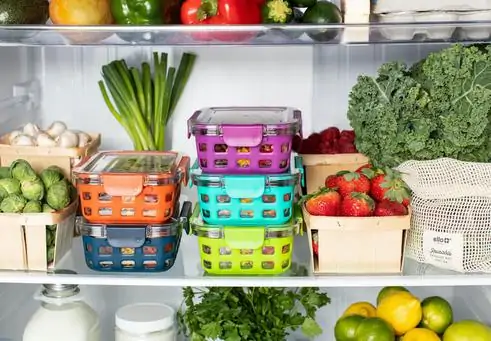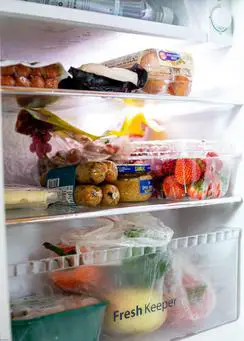If you’re like most people, when you see a blue light blinking on your Samsung refrigerator, you have no idea what it means. You may even be worried that there’s something wrong with your fridge and that you need to call a technician.
Don’t worry – you’re not the only one who doesn’t know what the Samsung refrigerator blinking blue light means. Most people don’t know.
The good news is that we’re here to help. In this blog post, we’ll tell you everything you need to know about the blue light blinking on your Samsung fridge, including what it means and what you should do about it.
What Does A Blinking Blue Light Mean?
So, what does the blinking blue light on a Samsung refrigerator mean?
Simply put, it means that your fridge is in Cooling Off mode. When you see the blue light blinking, it means that your fridge is working to reach the set temperature. Once the desired temperature is reached, the blue light will stop blinking and stay on steadily.
There are a few reasons why your fridge might enter Cooling Off mode, including:
- The door was opened too frequently or left open for too long
- The room temperature is too warm
- You recently added new food to the fridge
If you see the blue light blinking, don’t panic. It’s not a sign that something is wrong with your fridge. It’s simply a sign that your fridge is working hard to reach the set temperature.
WIll The Blinking Blue Light Damage My Refrigerator?
The blue light on your Samsung refrigerator is a very good thing! It means that the fridge is working properly and cooling your food. However, if you’re noticing that the blue light is blinking more frequently than usual, it could be a sign that the fridge is overworking itself and may need to be serviced. If you’re ever concerned about the blue light on your fridge, simply give Samsung a call and they’ll be able to help you out.
Causes Of Blinking Light On Samsung Fridge
There are a few potential causes of your fridge’s blue light blinking. If you’ve recently installed your fridge, the blue light may be blinking due to a power surge. To fix this, simply unplug your fridge for 30 seconds, then plug it back in. This should reset the fridge and stop the blue light from blinking.
If your fridge is older, or if you haven’t installed it recently, the blue light may be blinking due to a power issue. Check to make sure that the outlet your fridge is plugged into is receiving power. If not, reset the circuit breaker or replace the fuse. Once the power is restored, your fridge should work properly.
How To Stop Samsung Refrigerator Blinking Blue Light
If you want the blue light to stop blinking, there are a few things you can do:
- Close the fridge door and wait a few minutes. The blue light should stop blinking within a few minutes.
- If the room temperature is warm, turn on the air conditioning or open a window to cool down the room.
- Remove any new food that you’ve recently added to the fridge.
Remember, if you see the blue light blinking on your Samsung refrigerator, don’t panic. It’s not a sign that something is wrong with your fridge. It simply means that your fridge is in Cooling Off mode and is working to reach the set temperature. Once the desired temperature is reached, the blue light will stop blinking and stay on steadily.
What Is The Samsung Refrigerator Blue Water Line?
The blue water line is a feature on Samsung refrigerators that provides filtered drinking water. This feature is usually located in the door, and it has a small button or lever that you can press to dispense water. The blue light on the refrigerator indicates that the filter is working properly and that the water is safe to drink.
If the blue light is blinking, it means that there is a problem with the filter. It is important to replace the filter as soon as possible to ensure that you have safe, filtered drinking water.
How To Reset Your Samsung Refrigerator
In the case of a malfunctioning refrigerator, it’s understandable to be concerned.
High energy costs, damaged food, and cryptic error messages are all potential consequences of a malfunctioning refrigerator.
As clever as Samsung fridges are, they’re still susceptible to simple mistakes. Fortunately, most Samsung refrigerator issues may be solved with a simple reset.
If you’re concerned about:
- Shop mode is still active in your fridge.
- The temperature reading is inconsistent or flashing.
- There was a power outage in your area lately.
- You’ve encountered a problem.
Tips For Resetting Samsung Refrigerators In A Flash
Samsung refrigerators may be reset by holding down both the power freeze and power cool buttons at the same time. If it doesn’t work, unplug the refrigerator for 30 seconds and try again. When all else fails, you may look up error codes on the internet. Please see below for further information. Troubleshooting an appliance should begin by consulting its user handbook.
How To Maintain Your Samsung Refrigerator
First and foremost, it’s important to keep your Samsung refrigerator clean. A build-up of dirt and grime can cause the blue light to blink. To clean your fridge, unplug it and remove all food items. Then, use a mild detergent and a soft cloth to wipe down the interior surfaces. Be sure to pay special attention to the gasket, as this is where most dirt and grime accumulate. Once you’re finished cleaning, dry the surfaces with a clean towel and then replace all of the food items.
It’s also important to keep your Samsung refrigerator properly maintained. This means regularly checking the door seals and gaskets to make sure they’re clean and free of dirt and debris. You should also make sure the fridge is level, as an unlevel fridge can cause the door to not close properly, which can in turn cause the blue light to blink. If you notice any problems with your fridge, be sure to contact a qualified repair technician for assistance.
Final Thoughts
All in all, a blinking blue light on your Samsung refrigerator is nothing to worry about. In most cases, it simply indicates that the water filter needs to be replaced. However, if the light is accompanied by other strange behavior from your fridge, it’s always best to call a professional for help. Thanks for reading! We hope this article was helpful.


